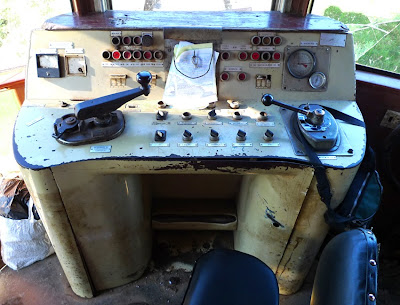 |
| Fortunately, control console looks like it was built to last. |
I use the moment to take a closer look at the driver's operating station. One front window is starred by a crack. Tight against the glass is a battered control panel with big levers I imagine are for throttle and brakes. Above the levers are lines of metal-collared buttons that make me think of the old lathes we used in high school machine shop.
The men climb back up and we resume our trip. As we come into Havana, the views change. We pass structures that could be factories or military installations, or both. At a table next to the track, an outdoor butcher wraps portions. Farther along, garbage overflows from metal drums.
Then we're moving between houses, so close I wonder if I could reach in a window and pluck a coffee cup from a kitchen table. Moments later we emerge into a broad street — we've reached Casablanca Station, the line's western terminus. Across Havana Harbour, we can see the central city. The railway never got that far. Milton Hershey's efforts to extend his line into Havana proper are said to have been blocked by United Railways, the main operator in Havana Province.
Frustrating for Hershey, no doubt, but just another fact of travel for those who ride on his electric railway all these years later. In seconds the train is empty, the passengers already moving to the ferry dock next door for the last leg of their journey.
 |
| Guarded facility in the Havana outskirts. |
 |
| A butcher at work trackside. |
 |
| Casablanca Station: End of the line for travellers heading west. |